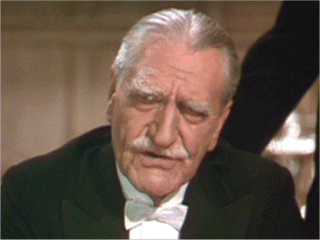One of the joys of watching (old) movies is the delight of recognizing familiar actors and actresses — the ones who basically played the same character over and over in different films, in different costumes, in different historical settings, but essentially “That Guy.”
C. Aubrey Smith as the Earl of Dorincourt
in Little Lord Fauntleroy, 1936
We’ve all seen Sir Charles Aubrey Smith (1863 – 1948) in many films over the years One of my favorites is the classic
Prisoner of Zenda with Ronald Coleman in the double role of the King and the Englishman, Douglas Fairbanks, Jr. as the sword-wielding villain, making this a triple threat British historical epic. Ignore the silly plot and enjoy the faces! You’ll also see Madeleine Carroll, Mary Astor, David Niven, and Raymond Massey in the cast.
Here is a clip from Turner Classic Movies.
(Sorry about the ad, but it can’t be helped I guess.)
Smith, Coleman and Niven in The Prisoner of Zenda
Smith, who held a degree from Cambridge, was a championship Cricket player in Britain and South Africa.
He appeared frequently on the London stage and when he turned to film, moved to Hollywood. He appeared in dozens of films, the perfect British officer, European aristocrat, grandfatherly gentleman, and sometimes even a villain.
Shirley Temple and Smith in Wee Willie Winkie, 1937
Rudyard Kipling’s story was the basis for this 1937 vehicle for Shirley Temple and her dimples. Set in the 19th century British Raj in India, it co-starred Smith as the Colonel/grandfather.
As General Burroughs in Four Feathers, 1939
Based on the novel by A. E. W. Mason, Four Feathers is a well-known story of 19th century cowardice and heroism. It is renowned for its desert scenes filmed in the Sudan, often compared to the brilliance of Lawrence of Arabia.
C. Aubrey Smith, C.B.E.
Smith played the role of the Chancellor of Oxford in The Adventures of Mark Twain, 1944, starring Frederic March in the title role.
Smith was named a commander of the Order of the British Empire in 1938; King George VI knighted Smith in 1944.
Smith and Margaret O’Brien in Little Women, 1949
Released after his death in 1948, Little Women was Smith’s last film. It was the top grossing film of the year.
During his many years in Hollywood in the 1930’s and later, Smith organized popular cricket matches with teams drawn from some of the industry’s most famous British stars, such as Coleman, Fairbanks, Niven, Laurence Olivier, Errol Flynn, Leslie Howard, Cary Grant, Nigel Bruce, Basil Rathbone, and writer P.G. Wodehouse.
Oddly enough, while a young man, Smith had settled in South Africa to prospect for gold in 1888-89. While there he developed pneumonia and was wrongly pronounced dead by doctors. Fifty years on, in 1948, Smith did actually succumb pneumonia. He died in Beverly Hills at age 85.
.jpg)






A fine actor. Whenever I see his name in the opening credits of a movie, I know it will be one to watch. So lucky we have TCM to see some of his performances. Thanks for sharing this interesting information on Sir Charles Aubrey Smith!
You are most welcome…he is one of my faves too.
Oh, I love him! I know him best through the 1939 version of And Then There Were None, and one of the Thin Man movies. Thanks so much!
Oh wow. I remember him! He has the most amazing face! So aristocratic and so reassuring. And Birdie, And Then There Were None is an old favorite of mine!